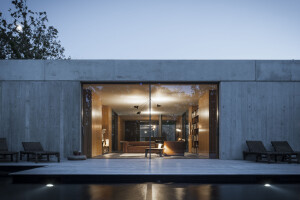Recognizing that students are the creators of our collective future, Discovery Elementary sets the stage for the development of the skills necessary for long-term stewardship of our world.'
Discovery Elementary School is Arlington Public Schools’ first elementary school designed in the 21st century. While built to address rapidly growing student enrollment in Arlington, the school was designed to meet a larger goal – to prove what can truly be achieved with a new public school facility. To this end, careful attention was focused on designing and building a school that supports how and where students learn. Every nook and cranny of the school is arranged to create a seamless integration between design, sustainability, and learning. Recognizing that students are the creators of our collective future, Discovery Elementary sets the stage for the development of the skills necessary for long-term stewardship of our world.
The school was designed to be a “net zero energy” building, meaning that the amount of energy produced annually by on-site renewable energy sources is equal to the amount of energy used annually. Discovery is anticipated to become the first net zero energy school in the Mid-Atlantic and the largest in the United States. As a carbon neutral producer of clean energy, the school offers a positive example of a solution to a global crisis – and along the way emboldens students with the expectation that they are creative participants in those solutions.
Nestled near the nation’s capital, Arlington County is one of the fastest growing counties in Virginia. As such, the need for contextual sensitivity with the rapidly urbanizing neighborhood and adaptability for after-hours use were top concerns. The school shares the site with an existing middle school and has been master planned for future middle school expansion. Open, programmable space is preserved as much as possible by situating a full third of the building’s footprint on existing slopes. The school tiers into an existing hill to minimize the perception of its size while featuring exterior materials that are residential in nature and scale. Pre-K and Kindergarten students are grouped into three “kinderhouses” that mimic the size and spacing of adjacent homes.
To support ownership of the new school, the mascot, colors and school name were chosen by a vote of the student body. The “Discovery Explorers” name reflects the forward-looking, inquiry-based learning that takes place in the building. The school name also serves as a tribute to John Glenn, who lived adjacent to the site when he became the first American to orbit the earth in 1962. In 1998, while still a sitting senator, Glenn returned to space as a crew member of the space shuttle Discovery, becoming the oldest person to fly in space.
The school’s design takes advantage of the topography of the site to create distinct, tiered academic zones and separate exterior play spaces for early childhood, primary, and elementary grade levels. Discovery’s public spaces are defined by a large roof canopy with a cedar soffit that runs the length of the school and serves as the school’s “front porch.” At the main entry, the roof extends out as a canopy with an oculus, which allows the entry plaza to serve as a large solar calendar that indicates both time of day and time of year.
Light is celebrated in multiple ways throughout the school, culminating in a rooftop solar lab that allows students to conduct real time and on-going experiments. Data from these experiments can be tracked and graphed using a building dashboard system accessible on any device in the school. The street side of the school is accented with warm colors – reflecting their south-facing solar orientation. On the north side, the school uses playful arrangements of cool colors, such as greens and blues, echoing the natural expression of moss that grows on the north side of trees.
The school’s wayfinding goes beyond basic navigation to support a larger vision of spatial organization that reflects each grade’s expanding curriculum and identity. As students progress through the school, their “world expands” – with the first floor themed around animals found in earth eco-systems and the second floor themed around the elements of the sky and heavens. Students start out as Backyard Adventurers in Kindergarten and finish Fifth Grade as Galaxy
Voyagers. This storyline is graphically communicated along an entry wall highlighting each Explorer grade level. On the first day of school, Explorers are able to “make their mark” in their expanding world by signing their name on the wall – and follow along as the mark moves down the wall over their six year journey at Discovery.
“This is the greatest green school I’ve ever seen. It is fully integrated with the educational program and serves as a pedagogical tool. VMDO does a great job at partnering with educators to ensure the educational aspect is a leading thought, not an afterthought.” - Rachel Gutter Director, Center for Green Schools








































